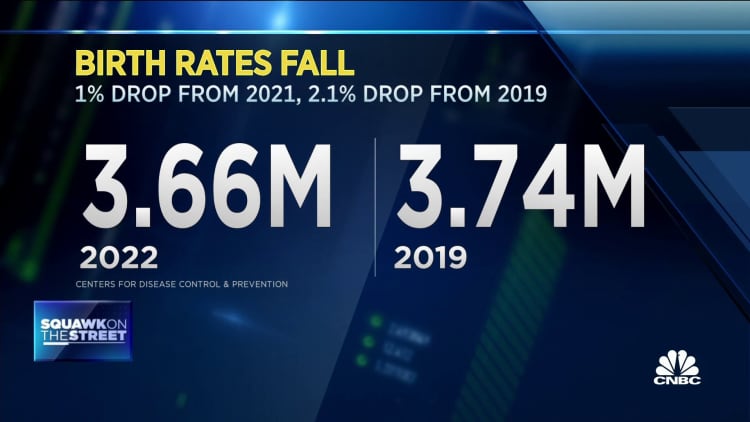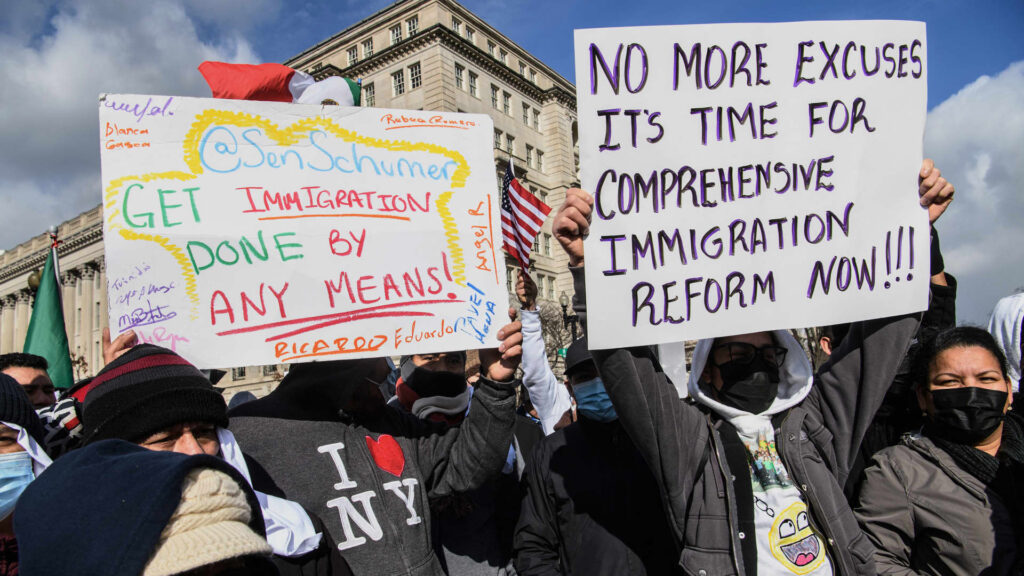Demonstrators call for immigration reform near the White House on Feb. 14, 2022.
Nicholas Kamm | AFP | Getty Images
As the U.S. fertility rate continues to fall, there are growing concerns about the long-term economic impact: A smaller population means less tax revenue, which could reduce funding for programs such as Social Security and Medicare.
But immigration policy reform could be one solution, some experts say.
Lea este artículo en español aquí.
The U.S. birth rate fell slightly in 2022 compared with 2021, with roughly 3.7 million babies born nationwide, and the birth rate still hasn’t recovered to pre-pandemic levels, according to an initial analysis from the Centers for Disease Control and Prevention.
A growing concern for economists, the U.S. fertility rate has generally been below the replacement rate — which is needed to maintain the current population — since 1971 and has consistently been below the replacement rate since 2007.
More from Year-End Planning
Here’s a look at more coverage on what to do finance-wise as the end of the year approaches:
“The tax base is shrinking, and allowing immigrants to come in lawfully is an easy solution to that,” said Jackie Vimo, senior economic justice policy analyst at the National Immigration Law Center. “It’s the answer hiding in plain sight.”
In 2022, foreign-born U.S. residents — including legally admitted immigrants, refugees, temporary residents and undocumented immigrants — represented about 18% of U.S. workers, up from 17.4% in 2021, according to the U.S. Bureau of Labor Statistics.
A pathway to citizenship for undocumented immigrants would offer eligible workers better education and employment opportunities while boosting federal tax revenue, Vimo said.
Reform could offer ‘huge benefits’ to tax base
Depending on the scope of changes, immigration policy reform could provide “huge benefits” to the U.S. tax base and economy, said Silva Mathema, director for immigration policy at the Center for American Progress.
In a 2021 report, the organization modeled the economic impact of four scenarios involving a pathway to legalization and citizenship for undocumented immigrants.
The most comprehensive option — a pathway to citizenship for all undocumented immigrants — would increase the U.S. gross domestic product by a total of $1.7 trillion over 10 years and create 438,800 new jobs, according to the report. Eligible workers would earn $14,000 more annually after 10 years.

“Immigrants currently without a pathway to citizenship pay billions in taxes, even though they don’t benefit from many of the programs they pay into,” such as Social Security and Medicare, Vimo said.
Undocumented immigrant-led households paid an estimated $18.9 billion in federal taxes and $11.7 billion in combined state and local taxes in 2019, according to the American Immigration Council.
However, other experts caution that growing the U.S. population through expanded immigration may not boost tax revenue as expected because there’s little control over the ages of new residents.
Immigrants currently without a pathway to citizenship pay billions in taxes, even though they don’t benefit from many of the programs they pay into.
Jackie Vimo
Senior economic justice policy analyst at the National Immigration Law Center
“You will have a bigger economy, and you will have more tax revenue, but you will also have more people,” said Steven Camarota, director of research for the Center for Immigration Studies. “There’s no evidence your per capita GDP will go up.”
The challenges of ‘common-sense policy’
It’s been nearly 40 years since the country made significant changes to immigration policy. The Immigration Reform and Control Act of 1986 “reset the clock on undocumented immigration” but didn’t address future inflows or ways for people to enter the country lawfully, Vimo said.
“That’s the problem we’ve been facing for decades now,” she said. “And unfortunately, there hasn’t been a political environment in Washington to implement what is common-sense policy.”
While nearly three-fourths of Americans say it’s “unacceptable” for people to immigrate illegally to the U.S., 56% support making legal immigration easier and 55% support a pathway to citizenship for undocumented immigrants who are already here, according to a 2021 survey of 2,600 U.S. adults by the Cato Institute.
“The biggest hurdle has been polarization and politicization of immigration,” Mathema said.
[ad_2]
Source link













